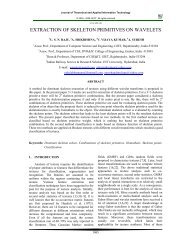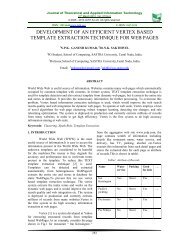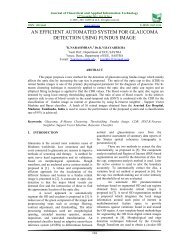Full Text - Journal of Theoretical and Applied Information Technology
Full Text - Journal of Theoretical and Applied Information Technology
Full Text - Journal of Theoretical and Applied Information Technology
Create successful ePaper yourself
Turn your PDF publications into a flip-book with our unique Google optimized e-Paper software.
<strong>Journal</strong> <strong>of</strong> <strong>Theoretical</strong> <strong>and</strong> <strong>Applied</strong> <strong>Information</strong> <strong>Technology</strong><br />
10 th June 2013. Vol. 52 No.1<br />
© 2005 - 2013 JATIT & LLS. All rights reserved .<br />
ISSN: 1992-8645 www.jatit.org E-ISSN: 1817-3195<br />
into two steps: first, source node send the<br />
information to relay nodes <strong>and</strong> destination node,<br />
<strong>and</strong> relay node process the received information;<br />
next, source node <strong>and</strong> relay node send the<br />
information to destination node, then destination<br />
node combined the received information by some<br />
method <strong>of</strong> combining.<br />
The way, which the information sent from source<br />
node <strong>and</strong> processed by relay node is forwarded to<br />
the base station, is divided into the following<br />
several kinds: amplify forward, decode forward <strong>and</strong><br />
coding cooperative, according to the original<br />
coding method, the information gained from<br />
judgment is transferred to the destination node in<br />
the second step. In this process, the performance is<br />
improved by the retransmission <strong>of</strong> redundant<br />
information in different space. In coding<br />
cooperative, corporate users decode the received<br />
signal in perspective, <strong>and</strong> then pass to destination<br />
after coding. Its basic idea is: every user try best to<br />
send redundancy increment <strong>of</strong> information for its<br />
partners. The process is to add the different<br />
redundant information to sign by code in order to<br />
gain double redundant <strong>of</strong> space with code <strong>and</strong><br />
achieve double diversity <strong>of</strong> air-space with codespace.<br />
Coding Cooperative mode can be divided<br />
into CC(Coding Cooperative) <strong>and</strong> STCC(Space<br />
Time Coded Cooperation). The user in CC only<br />
send message from itself Multi-access channels,<br />
<strong>and</strong> the user in STCC send message from itself <strong>and</strong><br />
corporate users Multi-access channels, The user in<br />
CC only send message from itself Multi-access<br />
channels, <strong>and</strong> the user in STCC send message from<br />
itself <strong>and</strong> corporate users Multi-access channels.<br />
source relay sink<br />
Fig.1 diversity <strong>of</strong> wireless networks<br />
Firstly, the studies <strong>of</strong> cooperative diversity<br />
technology are concentrated on how to generate the<br />
diversity combating fading at the moment, <strong>and</strong> the<br />
classic relay channel theory proposed by Cover <strong>and</strong><br />
Ei Gamal mainly analyze the capacity <strong>of</strong> channel<br />
<strong>and</strong> throughput under Additive White Gaussian<br />
Noise channel17. Secondly , the purpose <strong>of</strong> relay is<br />
to help main channel in the relay channel, but the<br />
resources <strong>of</strong> whole system are constant in<br />
cooperative communication, the user acts as<br />
information source <strong>and</strong> the relay. Besides<br />
AF(Amplify Forward), DF(Decode Forward) <strong>and</strong><br />
CC mentioned above, another important treatment<br />
method for cooperation is Detection Relay, which<br />
is pretty close to the traditionary relay method. In<br />
detection relay, the user first attempts to detect bit<br />
<strong>of</strong> partner specified by base station <strong>and</strong> some<br />
technologies, then resend the detected bit.<br />
Depending on the condition <strong>of</strong> cooperation between<br />
two users, then in practice, each user has a partner<br />
to provide the second path for it, <strong>and</strong> so diversity is<br />
formed. The distribution <strong>of</strong> the partners is<br />
becoming a hot topic at present. We can refer to the<br />
case in the book written by Sendonaris, which bring<br />
more inspiration <strong>and</strong> enlightenment to the<br />
researcher. In addition, the cooperation mechanism<br />
<strong>of</strong> decode forwarding under CDMA, which the<br />
nodes <strong>of</strong> two users had teamed up in pairs, was<br />
analyzed in the book. Each user node had its own<br />
spreading codes. The data bit <strong>of</strong> two user were the<br />
functions <strong>of</strong> time, the distribution <strong>of</strong> signal power<br />
was reflected in the range <strong>of</strong> the signal, <strong>and</strong> each<br />
signal cycle included 3 bit interval. Each user sent<br />
itself bit information <strong>and</strong> detected the second bit <strong>of</strong><br />
other users in the first <strong>and</strong> second interval. Two<br />
users sent the linear combination involving the<br />
second bit <strong>of</strong> itself <strong>and</strong> its partners in the third<br />
interval. To the first, second <strong>and</strong> third interval, the<br />
power was variable, According to the condition<br />
between uplink <strong>and</strong> user channel, the related<br />
transmission power is optimized, the method had<br />
self-adaptability for the state <strong>of</strong> channel. The power<br />
is allocated by a<br />
i,<br />
j, which the average transmit<br />
power is invariant. In short, when the channel status<br />
was good, more power will be allocated for<br />
collaboration, otherwise the power will be<br />
decreased. This kind <strong>of</strong> signal processing<br />
mechanism is very simple <strong>and</strong> had self-adaptability.<br />
But to the clumping type sensor network, the<br />
mechanism had the following questions: first, the<br />
signal detection might be fail, the cooperation was<br />
unfavorable for the last detection made by the<br />
signal in the cluster head. Next, in order to have the<br />
optimal decoding, the cluster head needed to know<br />
the error characteristics <strong>of</strong> channel between nodes.<br />
In order to avoid the problem <strong>of</strong> error transmission<br />
mentioned above, a kind <strong>of</strong> mixed decoding<br />
forward method was developed by Laneman13, the<br />
user node could decode the data <strong>of</strong> its partner when<br />
the fading channel had higher SNR (Signal Noise<br />
Ratio), but when the channel had lower SNR, the<br />
user node returned to the non-collaboration.<br />
In AF mechanism, each user receive the signal<br />
with noise from the partner, <strong>and</strong> then resend the<br />
3
















